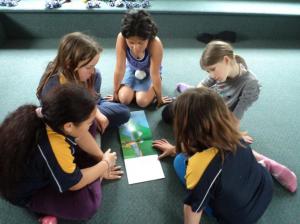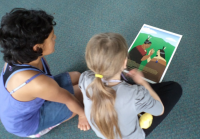Schools in the Taupō area, including Wairakei School, have worked in partnership with Ngāti Tūwharetoa to ensure students learn about their iwi, its history, places, and stories.
In 2009 the Tūwharetoa Māori Trust Board’s Education section approached a group of primary and secondary schools and early childhood centres in their local area to work together to develop a set of student resources based on local iwi and hapū knowledge.
Ngāti Tūwharetoa hapū, early childhood centres, the local principals’ cluster group and school Boards of Trustees agreed to support the project. Participants, including Wairakei Primary School, agreed to work with consenting Ngāti Tūwharetoa hapū to trial resources and ensure the materials were integrated meaningfully within their school-based curriculum.
Facilitating the process
The project was launched officially at Pūkawa Marae hosting kaumātua and kuia, representatives from the Ministry of Education, Tūwharetoa hapū, and educators from participating schools and early childhood centres. Throughout the following year another five hui were held on local marae attended by a variety of teachers and support staff, Board of Trustee members and groups from the community. The purpose of these meetings was to build teacher capacity and knowledge about the local area and to hear the stories from the local hapū themselves within their original context and setting. In this way participants were immersed in the history of the area and local historical settings from around Lake Taupō.
Hapū appointed facilitators with previous teaching experience. They consulted with each school and centre, collected information, and outlined the project and its objectives. A professional learning group made up of representatives from across the education sector in the rohe was formed to develop a trial resource pack. This first pack contained posters and parts of local stories supported by images and information about the heritage of Ngāti Tūwharetoa. It also included lesson plans and ideas about the way the resources could be used within classroom programmes. The group met regularly to talk about iwi stories and discuss the feedback from students and teachers.
The Tūwharetoa Cultural Knowledge Project team worked closely with the lead teachers appointed from each school to discuss their feedback, develop the resources and work alongside the professional learning group.
"The Tūwharetoa Cultural Knowledge Project has encapsulated our history and relationships to Ngātoro-i-rangi. It links the many landscapes, human and geographical to the 'place'".
Maria Rahui, Classroom teacher
Treaty of Waitangi principle
By inviting Māori whānau, hapū, and iwi to co-construct their local curriculum, Wairakei School incorporates the tikanga, values, and histories that are important to them and in turn, ensures that the Treaty of Waitangi principle underpins teaching and learning at their place.
Integrating resources into classroom programmes
Lead teachers introduced the trial resources in their schools and over time, staff reflected and gave feedback via surveys about how they could be strengthened to enhance their purpose.
When the trial was complete and the resources developed into their final version, each school was gifted a pack at an official launch of ‘Te Kete Rauemi’ at Waitetoko Marae where the resources were shared in a display for the wider community. Lead teachers from Wairakei and other participating schools and early childhood centres took parents and representative groups of students to be a part of the celebration. Hapū also had the opportunity to ‘teach’ teachers.
Wairakei Primary School dedicated time during staff meetings to discuss the implementation of the resources and develop teachers’ knowledge and understanding of the content. Teachers created displays of the resources and found students began retelling the stories and taking notice of the posters in the classrooms.
During this time the school was also in the process of developing their own localised curriculum, and by making links to these resources, they were able to create a continuous link to the knowledge of local iwi for classroom programmes across all levels.
"I enjoyed reading about Lake Taupō and seeing the stories in the books. The pictures were easy to follow."
Declan, 6 years
"I didn’t know that the All Black haka was written in our area."
Crucy, 11 years
"We learnt about our local leaders and how they supported other people."
Lilly, 9 years
Providing sufficient opportunities to learn in the social sciences
Through learning about the stories and histories of their local area, students from Wairakei School have had time and opportunity to develop conceptual understandings in the social sciences. They have explored the relationships that exist between people and the environment, and they have examined past events, experiences, and actions and the ways in which these have been interpreted over time.
The flow on effects of participating
As a result of their involvement in this project, Wairakei Primary School devised some supplementary goals to reflect the importance of this work within their school curriculum and ensure every teacher and student had some ownership of them.
Their goals state that:
- all children are to visit at least one Tūwharetoa heritage site and be able to tell the significance of the site for Tūwharetoa iwi
- all children and staff are to be able to say their mihi in front of a group
- all children are to able to retell a local legend
- all children are able to recite the school karakia without reading it from the PowePoint.
Many other cultural connections have been established as the result of this partnership process including the strengthening of relationships with Wairakei’s tuakana school, Taupo-nui-a-tia College. This has included taking part in pōwhiri at the college and preparing a hangi for the college on a return visit as an extension of manaakitanga.
As a school leader, principal Paula Farquhar said the involvement has been invaluable. It has supported her to focus school development on the local environment and utilise this knowledge. It has allowed her time to gain a deeper insight into the lives of her students specific to their heritage and to form strong connections with community leaders within the iwi.
The partnership has also been the catalyst for conversations about cultural responsiveness within the school. Workshops have been held on the topic and included input from both RTLBs and other school support staff.
Community engagement
The community engagement principle has been brought to life through this project. The teaching resources that have been developed have meaning for students and connect with their cultural heritage and local environment. The school is working with iwi leaders and the local secondary school to grow a more culturally responsive local curriculum.
Success factors of the partnership
The commitment of both the Tūwharetoa Cultural Knowledge Project team and the school-based lead teachers has made this project a success. Throughout the process, clear communication was established and maintained resulting in enthusiasm from teachers and community involvement. The process of developing the resources formed the foundation for the school’s localised curriculum and goal setting. This provided huge learning opportunities for teachers who were not connected to the iwi.
Teachers from all sectors across the cluster were able to work together to share ideas and be a part of the learning process. They were immersed in a variety of different cultural experiences that they were then able to bring back to their classroom programmes.
As teachers we are continuously looking at how we can engage our students in their learning while always making their learning meaningful. Working with the resources developed by the Tūwharetoa Cultural Knowledge Project we have been able to personalise the learning for our students. We have been able to engage with the iwi and in turn they have supported us and helped guide us in the development of our school-based curriculum.
Paula Farquhar, Principal
It has been humbling to be a part of the Tūwharetoa Cultural Knowledge Project. The project has enabled schools in the Taupo area to develop and impart the knowledge of the Tūwharetoa Iwi and the Tangata Whenua in a way that is sustainable for the future.
Danelle Unuwai, Lead Teacher Curriculum
Wairakei Primary School has felt privileged to be a part of the development of these resources, to learn about their local iwi, its history, the historical sites in the area and local stories relevant to them and their local environment.
You might like ...
Whose voices help to shape your local curriculum?
This blog provides ideas, questions, tools, and examples to help you design a local curriculum that reflects what is important to your community. The third section of the blog contains guidance on how to build educationally powerful partnerships with your Māori communities.
Review questions
"Strong engagement and contribution from students, parents and whānau, hapū, iwi, Māori organisations, communities, and businesses – have a strong influence on students’ success." Ka Hikitia - Accelerating Success 2013 -2017
- Having read this story, what new ideas could you adopt to sustain partnerships with local iwi?
- How could you increase culturally connections with your local place and people?
- How have you developed constructive and positive student centred partnerships in your school? What are your next steps?
- Tags:
- community engagement
- curriculum design and review
- primary
- social sciences
- treaty of Waitangi
Return to top


